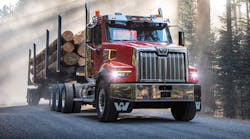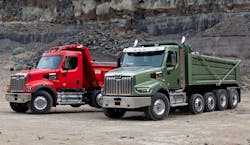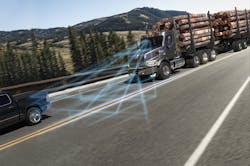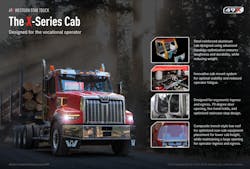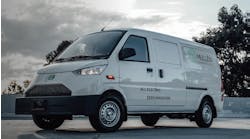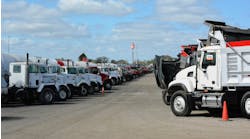Western Star introduces 49X next-generation vocational truck
Daimler Trucks North America (DTNA) has revealed the Western Star 49X vocational truck, which retains the brand’s tried-and-true toughness while integrating the safety-enhancing Detroit Assurance 5.0 advanced driver assist systems and versatile DT12 Vocational Series automated manual transmissions.
The synergistic approach to DTNA’s latest truck represents a new style of thinking for the truck manufacturer.
“We used to be Freightliner and Western Star, and it was very mutually exclusive,” said David Carson, senior vice president of vocational sales and marketing. “We now have a segment structure where we're very focused on the on-highway part of the business and on the vocational part of the business.”
This is shown through the development of the DT12 Vocational Series automated manual transmission (AMT), coming on the heels of the DT12 On-Highway Series AMT.
With two models available — the DT12-V and DT12-VX — Daimler AG spent $100 million to develop a transmission specifically designed for the vocational market, validated through 35 million miles of testing. These vocational-focused transmissions can be mated with the truck makers’ Detroit DD15 Gen 5 engine and Detroit DD16 engine as well as Cummins’ X-12 and X-15 engines.
The DT12-V offers torque inputs up to 2,250 lbs.-ft. and gross combined weight ratings (GCWR) of 160,000 lbs. and is best suited for construction and municipal work. The DT12-VX, which has bigger gears, can reach up to 2,500 lbs.-ft. (exceeding current engine capabilities) and GCWR of 330,000 lbs. Both are imbued with intelligent software settings such as Rock-Free Mode to shimmy the truck out of mud and Power Launch to get an initial boost forward. Customizable PTO presettings allow drivers to program the optimal rpm for a particular duty cycle.
The AMT also offers three driving modes: economic, performance and off-road.
The economic road is meant for highway driving. “[Drivers] may not always talk about fuel economy, but it's an expense that impacts their bottom line and their ability to be profitable,” said Samantha Parlier, vice president of Vocational Market Segment Development at DTNA.
Performance mode allows drivers “to pull a grade a little bit in the higher gear and hold the gear a little bit longer,” while off-road holds gear strips longer on soft or extreme terrain, she said.
The Detroit Assurance Suite adds side guard assist, Active Brake Assist 5, tailgate warning, adaptive cruise control to 0 mph, lane departure warning, video capture, intelligent high beam, and automatic wipers and headlamps.
The bumper and side sensors are reinforced to endure the unavoidable rock and debris collisions that a work truck must endure on the job site.
Getting to know the X-Series
According to DTNA, the new X-Series cab is the segment’s largest, with up to 13% more space than competitors. The door opens up to 70 degrees and has a single-piece windshield that is 28% bigger than that of the current Western Star 4900 and an optional three-piece rear window that is 77% larger.
The five handholds and wider staircase-style steps aim to prevent slips and falls. The C-Bar mirror frame can also hold the weight of a 350-lb. person.
The ISO Tech Hood Suspension System provides stability and reduces vibrations in the cab, which is expected to also reduce driver fatigue on bumpy terrain.
On the outside, the dual-stage LED headlight system, which has a 45-degree light pattern, has heating elements to evaporate condensation or melt 3 mm of ice in 10 minutes.
The Class 8 truck was clean-sheet designed to have best-in-class resisting bending moment (RBM) strength rating for single channel of up to 3.7 million inch-lbs., with available C-channel frame reinforcements to reach a 5.4 million inch-lbs. RBM rating.
The original Western Star 4900 released in 1968 was designed to perform logging operations in the unforgiving elements of the British Columbia wilderness. The 49X has that same rugged spirit, but a body able to keep up in the 2020s and beyond.
“We know the 4900 is a great product, but we also know that it doesn't bring the best of technology to the customer,” Parlier said. “So what we really focused on was how do we bring all of this great technology to help make the customer's job more efficient, more productive, and ultimately more profitable without losing all of the durability and toughness of the 4900.”
Therefore, the body was built on 50 years of experience using the latest engineering methods, such as topology optimization. This computer-aided design method allowed DTNA to keep the structure strong and roof low while cutting 350 lbs. of weight.
Upfitting is made easier through various considerations such as forward-mounted DEF tanks, multiple air tank mounting locations, and a compact Detroit aftertreatment system. The cab’s Quick Fit dashboard plate can be removed to install vocation-specific panels and access the truck’s computer system.
“You can pop this panel off, thread it up through, and if you want to, connect right into the truck’s brain,” Parlier said.
The truck was “torture tested” at DTNA’s structure lab in Portland, Ore., on shaker tables to ensure the chassis could withstand years of rough roads and rougher job sites. Road testing was performed at DTNA’s High Desert Proving Grounds in Madras, Ore., an area that offers every extreme environment and ground-type the truck may face.
“This truck has been to hell and back,” said Tracy Mack-Askew, DTNA general manager of heavy duty vocational platform.
Designed for the job
The 49X is the brand’s first new model since the 5700XE was launched in 2014. An upgraded 4700 also came out last year. Over the past six years, DTNA journeyed to the most extreme vocational jobsites, ranging from the arid oil fields of Texas’ Permian Basin to the snow-drenched winter roadways of New Hampshire—and listened to what those customers needed.
“We were able to capture those types of environments and stresses that are placed on a truck to ensure that this 49X would, in fact, be not only equivalent but even better than what we have today,” Carson said. “We’re all about our customer needs in the vocational segment, primarily because this is a product that will be owned for anywhere from 20 to 25 years.”
For instance, observing Michigan loggers helped the team understand the need for the Rock-Free Mode.
“They bury themselves up to the axles in mud and the drivers are by themselves,” said Parlier. “They load the trucks themselves, they go out into the woods themselves.”
She said they would park Caterpillar D12 bulldozers every five miles to push stuck trucks out of the muck. Drivers would have to make the long, lonely walk to one of these bulldozers, and then drive back to pull the truck out, wasting valuable time.
Now, the transmission can do that job.
“It allows the clutch to open and close. You use the throttle to rock yourself out and get moving, get momentum and get unstuck,” she explained.
Pricing for the 49X will be similar to the newer 4900 models and fleets can place orders this winter and start putting them to work in 2021.
